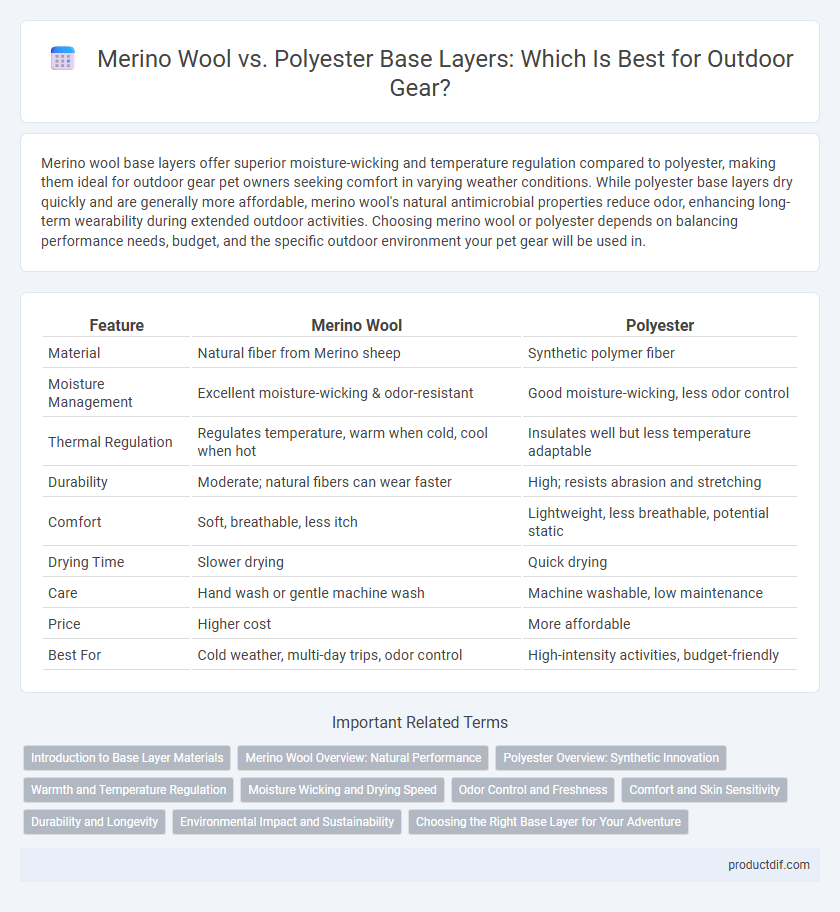Merino wool base layers offer superior moisture-wicking and temperature regulation compared to polyester, making them ideal for outdoor gear pet owners seeking comfort in varying weather conditions. While polyester base layers dry quickly and are generally more affordable, merino wool's natural antimicrobial properties reduce odor, enhancing long-term wearability during extended outdoor activities. Choosing merino wool or polyester depends on balancing performance needs, budget, and the specific outdoor environment your pet gear will be used in.
Table of Comparison
| Feature | Merino Wool | Polyester |
|---|---|---|
| Material | Natural fiber from Merino sheep | Synthetic polymer fiber |
| Moisture Management | Excellent moisture-wicking & odor-resistant | Good moisture-wicking, less odor control |
| Thermal Regulation | Regulates temperature, warm when cold, cool when hot | Insulates well but less temperature adaptable |
| Durability | Moderate; natural fibers can wear faster | High; resists abrasion and stretching |
| Comfort | Soft, breathable, less itch | Lightweight, less breathable, potential static |
| Drying Time | Slower drying | Quick drying |
| Care | Hand wash or gentle machine wash | Machine washable, low maintenance |
| Price | Higher cost | More affordable |
| Best For | Cold weather, multi-day trips, odor control | High-intensity activities, budget-friendly |
Introduction to Base Layer Materials
Merino wool base layers provide excellent moisture-wicking properties, natural odor resistance, and temperature regulation, making them ideal for varied outdoor conditions. Polyester base layers excel in durability, quick-drying capabilities, and affordability, offering effective synthetic insulation for active pursuits. Selecting between Merino wool and polyester depends on prioritizing natural fiber benefits or synthetic performance in base layer materials.
Merino Wool Overview: Natural Performance
Merino wool base layers offer exceptional moisture-wicking capabilities and natural temperature regulation, making them ideal for outdoor activities in varying climates. Their fine fibers provide superior breathability and odor resistance compared to synthetic polyester alternatives. The sustainable and biodegradable nature of Merino wool enhances its appeal for eco-conscious outdoor enthusiasts seeking both performance and environmental responsibility.
Polyester Overview: Synthetic Innovation
Polyester base layers, engineered from advanced synthetic fibers, offer exceptional moisture-wicking capabilities and quick-drying performance, making them ideal for high-intensity outdoor activities. Their durability and resistance to abrasions ensure long-lasting wear in rugged environments, while the lightweight construction enhances overall comfort and mobility. These features position polyester as a versatile innovation in outdoor gear, particularly for users prioritizing breathability and fast moisture management.
Warmth and Temperature Regulation
Merino wool base layers excel in warmth due to their natural insulating fibers that trap heat while remaining breathable, effectively regulating body temperature in cold outdoor conditions. Polyester base layers provide efficient moisture-wicking properties by drawing sweat away from the skin, which helps with temperature regulation during high-intensity activities but may lack the same insulating warmth as merino wool. Choosing between merino wool and polyester depends on the balance needed between warmth retention and moisture management for specific outdoor activities.
Moisture Wicking and Drying Speed
Merino wool base layers excel in moisture-wicking due to their natural fiber structure that pulls sweat away from the skin while maintaining breathability, keeping you dry and comfortable during outdoor activities. Polyester base layers often dry faster because synthetic fibers do not absorb water, making them ideal for high-intensity workouts where rapid moisture evaporation is crucial. Both materials offer effective moisture management, but choosing between merino wool and polyester depends on activity level, climate, and personal comfort preferences.
Odor Control and Freshness
Merino wool base layers naturally resist odor by trapping moisture while inhibiting bacterial growth, keeping you fresh during extended outdoor activities. Polyester base layers dry quickly but tend to retain sweat and bacteria, resulting in more persistent odors over time. Choosing merino wool ensures superior odor control and prolonged freshness, making it ideal for multi-day adventures.
Comfort and Skin Sensitivity
Merino wool base layers offer exceptional comfort with their natural softness and superior breathability, reducing the risk of irritation for sensitive skin. Polyester base layers excel in moisture-wicking and quick-drying capabilities but may cause itchiness or chafing for those with delicate skin. Choosing Merino wool provides a hypoallergenic option that maintains warmth while minimizing skin discomfort during outdoor activities.
Durability and Longevity
Merino wool base layers offer natural durability with resistance to odors and moisture, maintaining warmth even when wet, though they may be prone to pilling over time. Polyester base layers are highly durable, resistant to abrasion, and retain shape well after repeated washes, making them ideal for long-term use in rugged outdoor conditions. Choosing between the two depends on balancing natural fiber comfort and odor control against synthetic fiber resilience and extended wear.
Environmental Impact and Sustainability
Merino wool base layers offer superior biodegradability and renewable resource benefits compared to polyester, which is derived from non-renewable petroleum and contributes to microplastic pollution in oceans. While polyester base layers provide durability and moisture-wicking properties, they release synthetic microfibers during washing, posing significant environmental harm. Choosing Merino wool supports sustainable farming practices and reduces long-term ecological footprints in outdoor gear production.
Choosing the Right Base Layer for Your Adventure
Merino wool base layers excel in moisture-wicking, odor resistance, and temperature regulation, making them ideal for prolonged outdoor activities in variable climates. Polyester base layers offer superior durability, quick drying, and affordability, suitable for high-intensity adventures where frequent washing is required. Selecting between merino wool and polyester depends on your adventure's intensity, climate conditions, and personal comfort priorities.
Merino Wool vs Polyester Base Layers Infographic

 productdif.com
productdif.com